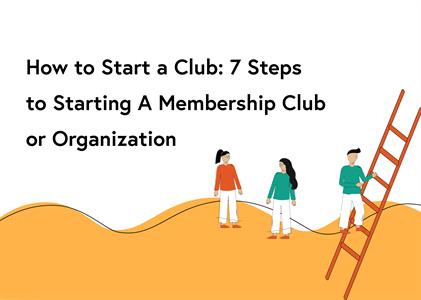

Have you recently picked up a new hobby or interest? Do you want to connect with others who share your same passion? Well, you can do this by starting a club! Think of all the clubs that could be in your community that may not exist yet: a motorcycle club, a pickleball club, a writer’s club or maybe even a Taylor Swift fan club. In this blog we’ll cover the general steps for making a club, tips for niche clubs, and the value of club management software.
The best part is your club can be anything your heart desires from social clubs and service clubs to sports and recreation clubs. Connect with like-minded people who share your values, hobbies or interests and start a club today!

If you’re looking for how to start a club, here are seven steps to consider, as well as some extra tips and information to get your club started right.
(And if you want to turn your club into a full-fledged nonprofit, check out our comprehensive guide on how to start a nonprofit the right way.)
The first step to take when making your own club is to gather the founding members, clarify the purpose of your club and identify any long-term goals you want to achieve.
Questions for founders to ask to identify a club’s purpose:
What’s the primary objective or mission you want your group to achieve? Are you looking to start a social club that meets regularly? Maybe you have a strong passion for a sport or hobby and are looking for others t hat share those feelings. For example, if you’re a huge baking aficionado, maybe you want to start a club centered around trying and sharing new dessert recipes.
Crafting a mission statement is a great way to clarify and articulate the reason for starting your social club, association or sports organization. Brainstorm with your co-founders and try to phrase your mission statement the way you’d tell a friend — m ake it engaging and simple enough to remember. To go back to our baking example, a potential mission statement might be “To improve our baking skills by trying new recipes and sharing cooking tips and tricks.”
Even though you’re just getting started, it’s important to consider the long-term goal(s) for the organization right from the very beginning. These goals will impact the next step of starting a club or organization: your club’s structure.
Here are a couple of questions for founders to ask to identify your club’s long-term goals:
Answering these questions before you begin to recruit other members will ensure that you and your co-founders are all on the same page. This will also make those first meetings run smoothly and feel more cohesive. Consider our baking example: if one member of your baking club thinks you’ll be baking during the meetings, and another thinks you’re supposed to bake beforehand and bring desserts to share, you might run into some frustrated (or hungry) members.

Once you’ve answered the questions above, you’ll have a better idea of your club’s structure.
The goal of a social club is to gather members for regular or semi-regular social activities. Typically, there will be very little overhead, loose structure and you’ll self-organize. Our baking club is a great example of this type of club.
If your club requires a steady cash flow in order to operate, you’ll need a formal organizational structure. This type of club has various moving parts that need management such as
A great example of this type of club would be a sports club. A sports club will need to rent field space and pay/manage volunteers or staff to handle the referee, coaching and equipment duties.
As soon as expenses and overhead costs are involved in achieving your club’s mission, you will need to consider ways to do the following:
In fact, for many clubs in this position, it makes sense to register as a non-profit or not-for-profit organization.
Clubs that intend to raise funds will also need to determine if they meet the administrative criteria in their region to qualify for tax exemption purposes. These criteria can differ according to your location. Make sure you check out the regulations of your country, state, and/or the province.
There are different types of non-profit or not-for-profit categories that will determine whether your club is eligible for tax-exempt status . In the U.S., the Internal Revenue Service (IRS) has rules governing social clubs that are entitled to tax exemption under Section 501(c)(7) .
Any club will need some sort of leadership or governing structure. You and your co-founders will determine whether the structure should be formal or relaxed. In other words, will you operat e through an elected Board of Directors or create a less formal club management arrangement?
Here are some of the key leadership roles to consider:
Make sure to develop and document clearly defined job descriptions for each role. Everyone involved should understand and agree to the expectations and responsibilities involved in taking on their role.
Once your club’s roles are defined, open up nominations and hold elections to be sure that roles are filled in a well-documented, democratic manner. As your club grows, you might need to consider adding new roles, or even an executive committee to help manage your operations.
Once you’ve established your organizational and leadership structure, as founders, you can help finalize the club’s mission statement. You’ll do this by establishing a charter and/or set of bylaws that govern the club and its members.
A formalized document–whether a constitution, charter, terms of reference, or set of bylaws – helps create a standard set of practices that are shared by club members, and creates a sense of order for your organization.
(Curious on how to write a club charter? Check out this WikiHow post.)

Now that you and your fellow founding members have created your club’s mission and objective s , it’ s time to start growing your membership. But first , you need to understand what people to target for recruitment.
Here are some great questions for founders to ask when identify potential club members:
For example, our baking club might only require an interest in baking and sweet treats. However, to start a professional association for dental hygienists, new members will obviously have to work in that field or study it.
As well as understanding the profile of your ideal membership, you need to clarify what you will offer new members. Essentially, what are the benefits they receive from joining your club.
Questions to ask to determine your membership levels and benefits:
PS: Managing these levels can also be done much more easily with the help of club management software.
So you’ve identified your ideal member profile and defined your membership benefits, now it’s time to develop a strategy for recruiting new members. Your strategy and the specific tactics you use will depend on the type of club you are creating. The following ideas will help you get started engaging existing members and growing your membership.
Here are a few ways to promote your club to new potential members:
Developing and maintaining effective financial records is the key to success for any club or organization. As your membership grows, financial record-keeping will become increasingly important. Get your financial records off on the right foot with these quick tips:
** Remember, most activities have some associated costs, so be sure to carefully map out your club’s yearly budget, pay attention to potential costs and sources of income. For example, our baking club might host a monthly bake sale to raise money for specialized baking supplies.
A website is key to presenting your club to the public — including many prospective members and the media. The key to an effective website is creating and publishing high quality content on a regular cadence, and making sure your content uses the latest search engine optimization (SEO) best practices.
A great club website outlines the benefits of membership and includes a membership application form for potential members to apply, connect, and ask questions. If you would like to see some great examples of club websites, check out this list of 7 club website examples.
There are many individual tools available to build and maintain a club website, but if you want an all-in-one tool, a purpose-built Membership Management Software (MMS) tool might be for you. WildApricot is the number one rated membership management software used by over 20,000 organizations across the world. The best part is that WildApricot has a free 60 day trial for anyone looking to use it. You can get your free trial here.



“As our club grew from the 60’s to in excess of 150 members and the need to collect dues and establish membership categories arose, it became very hard to manage everything with the paper system we had been using. WildApricot solved all that perfectly.”
– Fred Finney, Vistoso Cyclists
Once your club website is ready to go and you’ve started recruitment, it’s time to host your first meeting!
Although this may seem intimidating, don’t worry: all your new members are just as nervous as you.
We’d also recommend not trying to do too much in the first meeting. It’s best to keep it simple, and follow a structure such as:
And don’t forget to provide some time to mingle — the faster new members get to know each other, the easier it’ll be to keep them coming back to your next meetings.
As your wrap up the meeting, you should also let members know what they can expect from the club going forward. For example, will you hold weekly meetings, or limit it to once a month? Will the meeting location change? Setting out clear expectations will ensure members can feel comfortable coming back.
Congratulations — your club is all set up!
However, it’s not time to rest on your laurels just yet. There are a number of other things you’ll need to set up going forward in order to effectively engage with your club members .
Here are a few ideas we’ve seen successful clubs use in order to keep their members happy and their numbers growing.
Want to make sure all your members know when they can come to meetings? An online newsletter is a cost-effective way to:
An e-newsletter offers a means of promoting upcoming events and activities as well offering status updates on issues or other club news. Provide up-to-date information right into your members’ inbox through real-time delivery with an e-newsletter!
Keep in mind, it’s worth checking in with your members to see what kind of content they’d like to see from it. For example, if our baking club has been sending out weekly recipes but no one is opening their emails, it might be worth trying out a weekly “What our Members Baked This Week” instead.
Once you have created your club website, you might want to consider having “members-only” pages or sections – and a forum is a great way to get started. A forum is an online discussion site or place on your website where your members or supporters can post messages and others can view and reply to these messages.
A discussion forum allows club members to connect with one another and also offers your club leadership an opportunity to communicate with members. It can help you build your online community by providing a place for your members to congregate online, collaborate, discuss and share their ideas.
Have you considered how you’ll use social media to engage existing members and recruit new members?
While there is no one-size-fits-all strategy for launching into social media, most experts suggest that organizations new to social media take it slow and…
Your membership data is the heart of your club. With proper care and maintenance, your database can be used to engage your membership and grow a successful club or organization. A membership database allows you to learn which members stick around the longest and what they’re most interested in.
An up-to-date membership list is an invaluable tool to mail or email out meet-up invitations, promote events, advertise fundraising initiatives and request and receive member fees.
There are many ways to maintain a membership database , but if you want to ensure it is easily updated in real time, and available to the board members, staff and volunteers that need it, consider managing your database in the cloud – with online membership management software.
As your club continues to grow and evolve, you’ll want to make sure you continue serving the needs of your members — and the easiest way to do this is by asking them what they want.
Some ways you can do this are:
Once you’ve started your club, you may find management can be overwhelming without the right tools. Consider Member Management Software (MMS) to assist you with everything your club needs from building your club website to completing administrative tasks.
An MMS comes ready-made with all the elements your new club website will need, including:
Purpose-built Membership Management Software also automates most of the time-consuming administrative tasks associated with running a club or organization.
Some of the pre-packaged features Membership Management Software offers are:
WildApricot is a powerful cloud software that can help you automate and simplify everything when it comes to your new club. Check out our 60-day free trial to see what WildApricot can do for you!
Different clubs are going to have different needs. We’ve touched a bit on hobby clubs with our baking example, but we want to give you a couple more tips before sending you on your way!
How to Start a Social Club
A social club’s purpose is to connect with others over a common interest or activity. Ranging from sports to arts and crafts, there is always a need for a social club in your community. To start a social club, you’ll need to follow these quick steps:
With those four basic steps, anyone can start a social club! The bigger your club becomes, the more assistance you’ll need managing your membership. So, keep our earlier tips in mind once the Pickleball Pals take off!
A book club is one of the tried-and-true clubs that everyone loves. The beauty of a book club is it can have its own theme, per club or per book. For example, you may love to read only mysteries therefore, starting a mystery book club will be your go-to route. This ensures that all the club members will enjoy every book selected.
On the flip side, if you enjoy reading in general, the standard book club may be what’s best for you. Each month you can change genres (month 1 could be romance, month 2 could be sci-fi, month 3 could be historical fiction and so on).
Here’s some quick tips on starting a book club:
A motorcycle club is a club for those who are passionate about motorcycles. Frequently, these types of clubs are for those who ride motorcycles, but it can vary on the exact type of cycle. For example, the Oakland Motorcycle Club membership includes street riders, adventure, dual sport, dirt bikes and even scooters.
When looking to start a motorcycle club consider how exclusive you would like to be. Will your motorcycle club be specific to location, type of vehicle, frequency of ride or even whether you own a motorcycle or not. Your motorcycle club could meet solely for the appreciation of motorcycles and not just for those who ride them!
If you find yourself in middle school, high school or college chances are there is always a new club popping up to join. In addition to our earlier tips about starting a club, there will be other steps to take when starting a club at school.
Depending on your school’s structure, you will need to:
We hope these seven steps and quick tips are useful in helping you understand what’s involved in starting a club. While it might seem like there is a lot to think about in getting started, if you keep your initial shared passion alive as you build your club, all of the effort will be worthwhile.
Don’t forget to consider a Member Management Software to help you manage your website, members and administrative tasks. WildApricot is here for you with our all-in-one cloud software. Try a free 60-day trial now to empower you and your club members.
Good luck with starting your club!